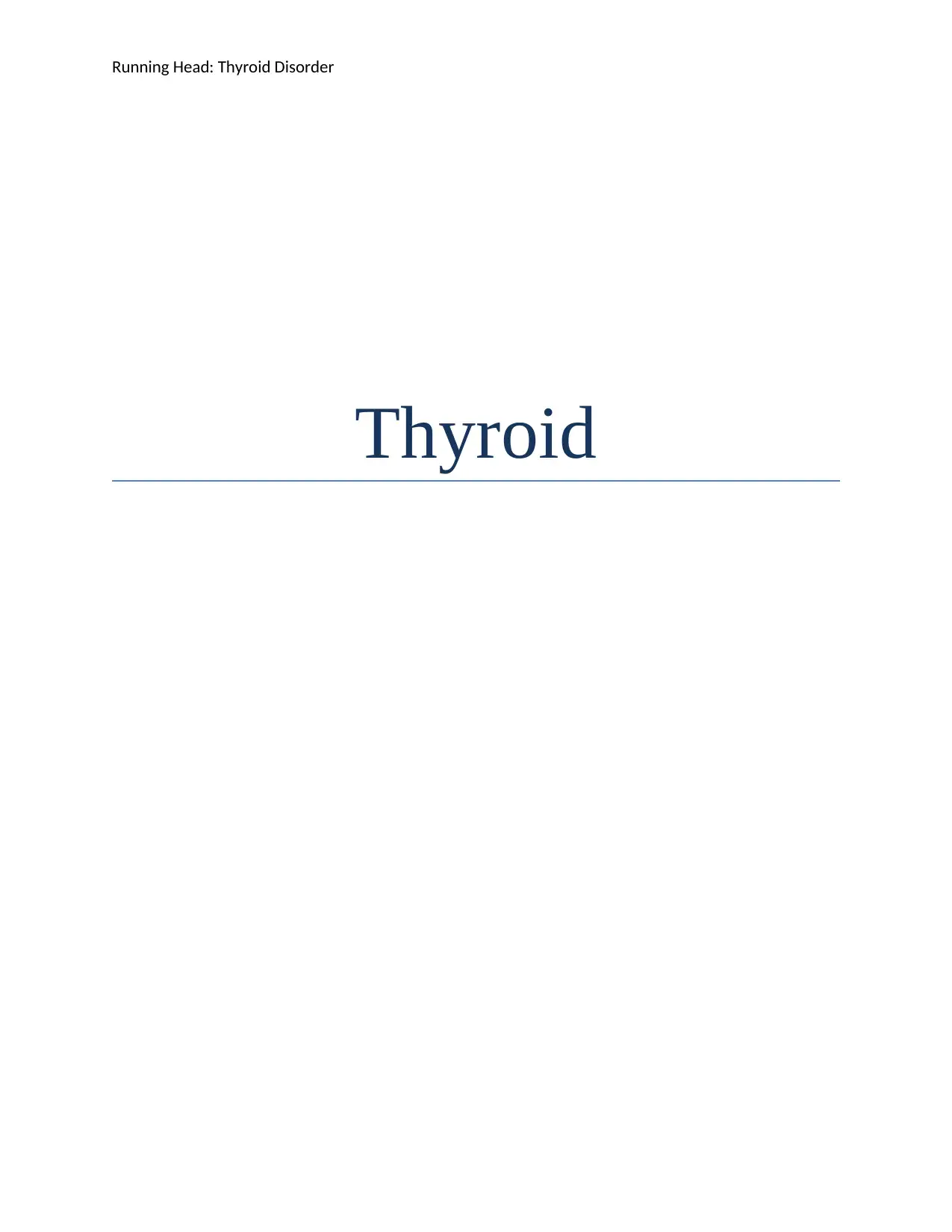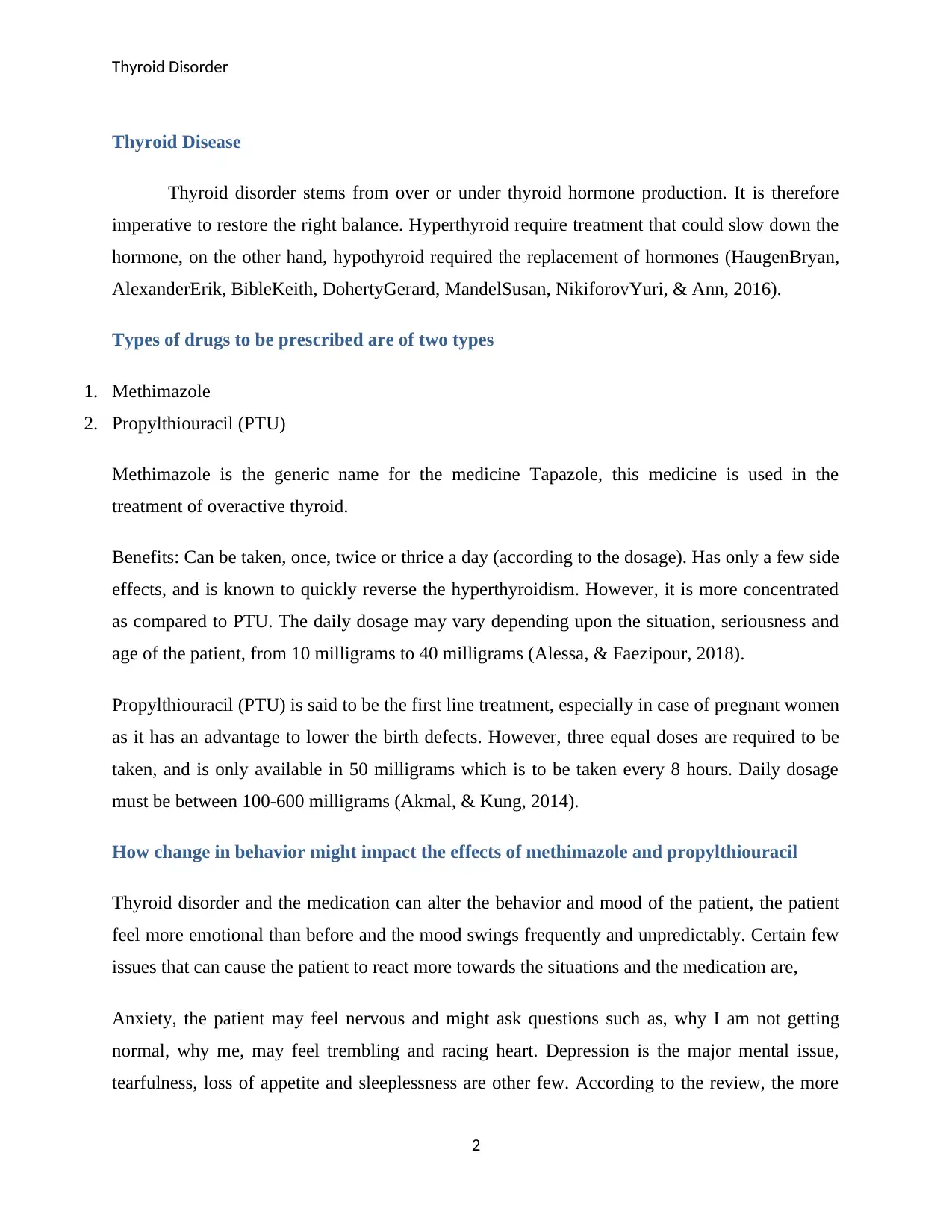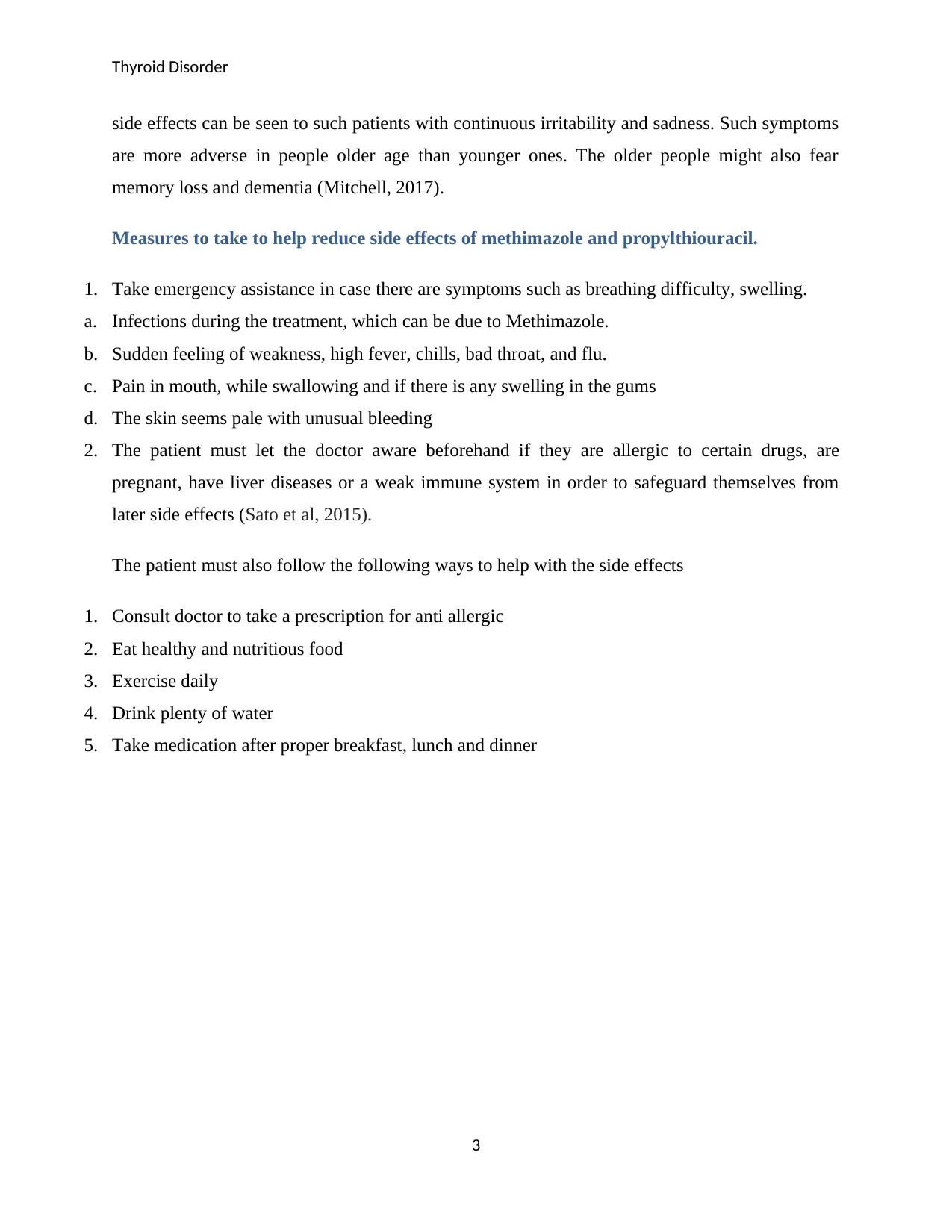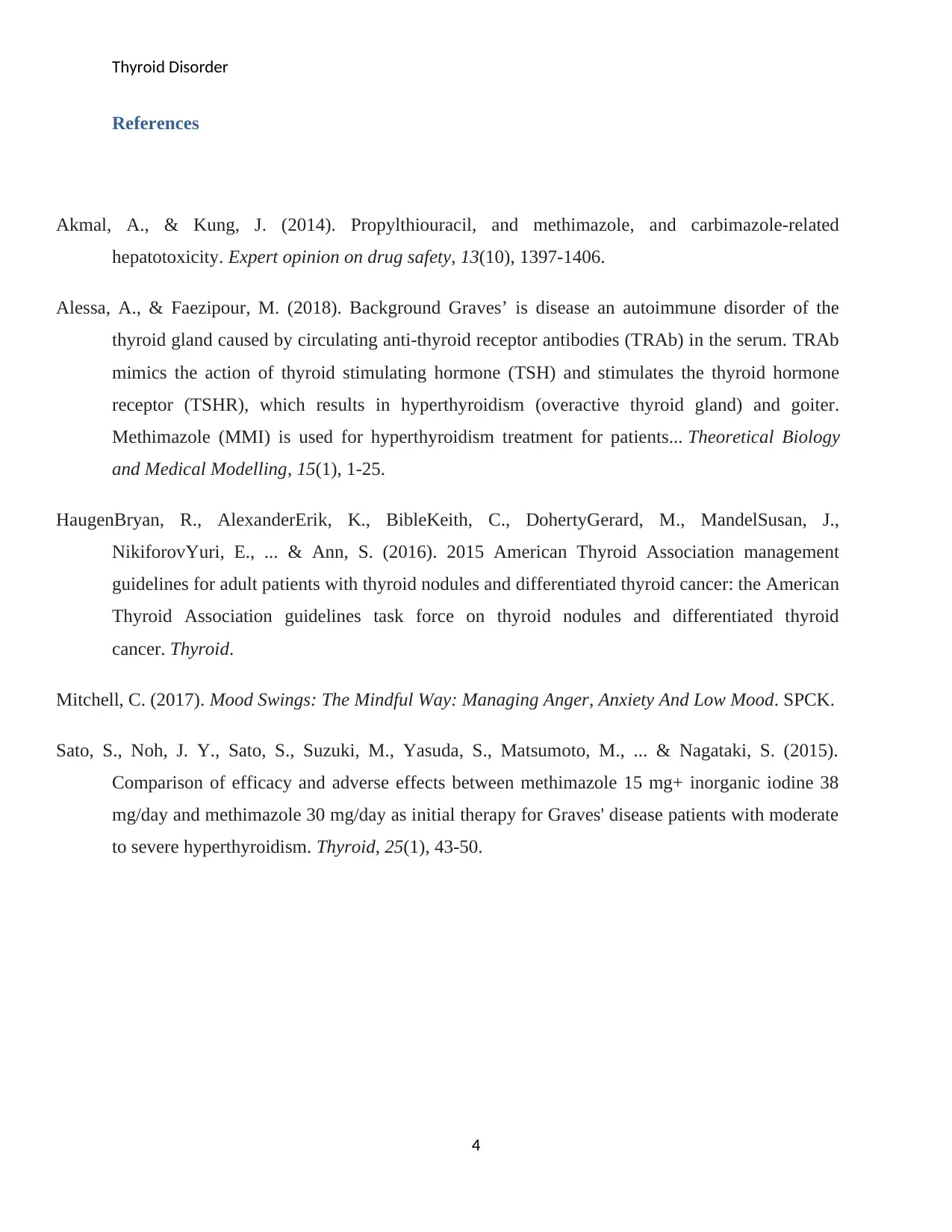Thyroid Disorder Report: Medications, Side Effects, and Behavior
VerifiedAdded on 2019/10/01
|4
|882
|178
Report
AI Summary
This report provides an overview of thyroid disorders, differentiating between hyperthyroidism and hypothyroidism, and the importance of restoring hormonal balance. It focuses on the medications Methimazole and Propylthiouracil (PTU), detailing their uses, benefits, and dosages. The report explores how these medications can influence patient behavior and mood, including potential issues like anxiety and depression, particularly in older patients. It outlines measures to reduce side effects, such as seeking emergency assistance and following medical advice. The report includes a comprehensive list of references supporting the information provided. This report is a valuable resource for understanding thyroid disorders, their treatments, and the behavioral and emotional impacts of medication.

Running Head: Thyroid Disorder
Thyroid
Thyroid
Paraphrase This Document
Need a fresh take? Get an instant paraphrase of this document with our AI Paraphraser

Thyroid Disorder
Thyroid Disease
Thyroid disorder stems from over or under thyroid hormone production. It is therefore
imperative to restore the right balance. Hyperthyroid require treatment that could slow down the
hormone, on the other hand, hypothyroid required the replacement of hormones (HaugenBryan,
AlexanderErik, BibleKeith, DohertyGerard, MandelSusan, NikiforovYuri, & Ann, 2016).
Types of drugs to be prescribed are of two types
1. Methimazole
2. Propylthiouracil (PTU)
Methimazole is the generic name for the medicine Tapazole, this medicine is used in the
treatment of overactive thyroid.
Benefits: Can be taken, once, twice or thrice a day (according to the dosage). Has only a few side
effects, and is known to quickly reverse the hyperthyroidism. However, it is more concentrated
as compared to PTU. The daily dosage may vary depending upon the situation, seriousness and
age of the patient, from 10 milligrams to 40 milligrams (Alessa, & Faezipour, 2018).
Propylthiouracil (PTU) is said to be the first line treatment, especially in case of pregnant women
as it has an advantage to lower the birth defects. However, three equal doses are required to be
taken, and is only available in 50 milligrams which is to be taken every 8 hours. Daily dosage
must be between 100-600 milligrams (Akmal, & Kung, 2014).
How change in behavior might impact the effects of methimazole and propylthiouracil
Thyroid disorder and the medication can alter the behavior and mood of the patient, the patient
feel more emotional than before and the mood swings frequently and unpredictably. Certain few
issues that can cause the patient to react more towards the situations and the medication are,
Anxiety, the patient may feel nervous and might ask questions such as, why I am not getting
normal, why me, may feel trembling and racing heart. Depression is the major mental issue,
tearfulness, loss of appetite and sleeplessness are other few. According to the review, the more
2
Thyroid Disease
Thyroid disorder stems from over or under thyroid hormone production. It is therefore
imperative to restore the right balance. Hyperthyroid require treatment that could slow down the
hormone, on the other hand, hypothyroid required the replacement of hormones (HaugenBryan,
AlexanderErik, BibleKeith, DohertyGerard, MandelSusan, NikiforovYuri, & Ann, 2016).
Types of drugs to be prescribed are of two types
1. Methimazole
2. Propylthiouracil (PTU)
Methimazole is the generic name for the medicine Tapazole, this medicine is used in the
treatment of overactive thyroid.
Benefits: Can be taken, once, twice or thrice a day (according to the dosage). Has only a few side
effects, and is known to quickly reverse the hyperthyroidism. However, it is more concentrated
as compared to PTU. The daily dosage may vary depending upon the situation, seriousness and
age of the patient, from 10 milligrams to 40 milligrams (Alessa, & Faezipour, 2018).
Propylthiouracil (PTU) is said to be the first line treatment, especially in case of pregnant women
as it has an advantage to lower the birth defects. However, three equal doses are required to be
taken, and is only available in 50 milligrams which is to be taken every 8 hours. Daily dosage
must be between 100-600 milligrams (Akmal, & Kung, 2014).
How change in behavior might impact the effects of methimazole and propylthiouracil
Thyroid disorder and the medication can alter the behavior and mood of the patient, the patient
feel more emotional than before and the mood swings frequently and unpredictably. Certain few
issues that can cause the patient to react more towards the situations and the medication are,
Anxiety, the patient may feel nervous and might ask questions such as, why I am not getting
normal, why me, may feel trembling and racing heart. Depression is the major mental issue,
tearfulness, loss of appetite and sleeplessness are other few. According to the review, the more
2

Thyroid Disorder
side effects can be seen to such patients with continuous irritability and sadness. Such symptoms
are more adverse in people older age than younger ones. The older people might also fear
memory loss and dementia (Mitchell, 2017).
Measures to take to help reduce side effects of methimazole and propylthiouracil.
1. Take emergency assistance in case there are symptoms such as breathing difficulty, swelling.
a. Infections during the treatment, which can be due to Methimazole.
b. Sudden feeling of weakness, high fever, chills, bad throat, and flu.
c. Pain in mouth, while swallowing and if there is any swelling in the gums
d. The skin seems pale with unusual bleeding
2. The patient must let the doctor aware beforehand if they are allergic to certain drugs, are
pregnant, have liver diseases or a weak immune system in order to safeguard themselves from
later side effects (Sato et al, 2015).
The patient must also follow the following ways to help with the side effects
1. Consult doctor to take a prescription for anti allergic
2. Eat healthy and nutritious food
3. Exercise daily
4. Drink plenty of water
5. Take medication after proper breakfast, lunch and dinner
3
side effects can be seen to such patients with continuous irritability and sadness. Such symptoms
are more adverse in people older age than younger ones. The older people might also fear
memory loss and dementia (Mitchell, 2017).
Measures to take to help reduce side effects of methimazole and propylthiouracil.
1. Take emergency assistance in case there are symptoms such as breathing difficulty, swelling.
a. Infections during the treatment, which can be due to Methimazole.
b. Sudden feeling of weakness, high fever, chills, bad throat, and flu.
c. Pain in mouth, while swallowing and if there is any swelling in the gums
d. The skin seems pale with unusual bleeding
2. The patient must let the doctor aware beforehand if they are allergic to certain drugs, are
pregnant, have liver diseases or a weak immune system in order to safeguard themselves from
later side effects (Sato et al, 2015).
The patient must also follow the following ways to help with the side effects
1. Consult doctor to take a prescription for anti allergic
2. Eat healthy and nutritious food
3. Exercise daily
4. Drink plenty of water
5. Take medication after proper breakfast, lunch and dinner
3
⊘ This is a preview!⊘
Do you want full access?
Subscribe today to unlock all pages.

Trusted by 1+ million students worldwide

Thyroid Disorder
References
Akmal, A., & Kung, J. (2014). Propylthiouracil, and methimazole, and carbimazole-related
hepatotoxicity. Expert opinion on drug safety, 13(10), 1397-1406.
Alessa, A., & Faezipour, M. (2018). Background Graves’ is disease an autoimmune disorder of the
thyroid gland caused by circulating anti-thyroid receptor antibodies (TRAb) in the serum. TRAb
mimics the action of thyroid stimulating hormone (TSH) and stimulates the thyroid hormone
receptor (TSHR), which results in hyperthyroidism (overactive thyroid gland) and goiter.
Methimazole (MMI) is used for hyperthyroidism treatment for patients... Theoretical Biology
and Medical Modelling, 15(1), 1-25.
HaugenBryan, R., AlexanderErik, K., BibleKeith, C., DohertyGerard, M., MandelSusan, J.,
NikiforovYuri, E., ... & Ann, S. (2016). 2015 American Thyroid Association management
guidelines for adult patients with thyroid nodules and differentiated thyroid cancer: the American
Thyroid Association guidelines task force on thyroid nodules and differentiated thyroid
cancer. Thyroid.
Mitchell, C. (2017). Mood Swings: The Mindful Way: Managing Anger, Anxiety And Low Mood. SPCK.
Sato, S., Noh, J. Y., Sato, S., Suzuki, M., Yasuda, S., Matsumoto, M., ... & Nagataki, S. (2015).
Comparison of efficacy and adverse effects between methimazole 15 mg+ inorganic iodine 38
mg/day and methimazole 30 mg/day as initial therapy for Graves' disease patients with moderate
to severe hyperthyroidism. Thyroid, 25(1), 43-50.
4
References
Akmal, A., & Kung, J. (2014). Propylthiouracil, and methimazole, and carbimazole-related
hepatotoxicity. Expert opinion on drug safety, 13(10), 1397-1406.
Alessa, A., & Faezipour, M. (2018). Background Graves’ is disease an autoimmune disorder of the
thyroid gland caused by circulating anti-thyroid receptor antibodies (TRAb) in the serum. TRAb
mimics the action of thyroid stimulating hormone (TSH) and stimulates the thyroid hormone
receptor (TSHR), which results in hyperthyroidism (overactive thyroid gland) and goiter.
Methimazole (MMI) is used for hyperthyroidism treatment for patients... Theoretical Biology
and Medical Modelling, 15(1), 1-25.
HaugenBryan, R., AlexanderErik, K., BibleKeith, C., DohertyGerard, M., MandelSusan, J.,
NikiforovYuri, E., ... & Ann, S. (2016). 2015 American Thyroid Association management
guidelines for adult patients with thyroid nodules and differentiated thyroid cancer: the American
Thyroid Association guidelines task force on thyroid nodules and differentiated thyroid
cancer. Thyroid.
Mitchell, C. (2017). Mood Swings: The Mindful Way: Managing Anger, Anxiety And Low Mood. SPCK.
Sato, S., Noh, J. Y., Sato, S., Suzuki, M., Yasuda, S., Matsumoto, M., ... & Nagataki, S. (2015).
Comparison of efficacy and adverse effects between methimazole 15 mg+ inorganic iodine 38
mg/day and methimazole 30 mg/day as initial therapy for Graves' disease patients with moderate
to severe hyperthyroidism. Thyroid, 25(1), 43-50.
4
1 out of 4
Related Documents
Your All-in-One AI-Powered Toolkit for Academic Success.
+13062052269
info@desklib.com
Available 24*7 on WhatsApp / Email
![[object Object]](/_next/static/media/star-bottom.7253800d.svg)
Unlock your academic potential
Copyright © 2020–2025 A2Z Services. All Rights Reserved. Developed and managed by ZUCOL.



